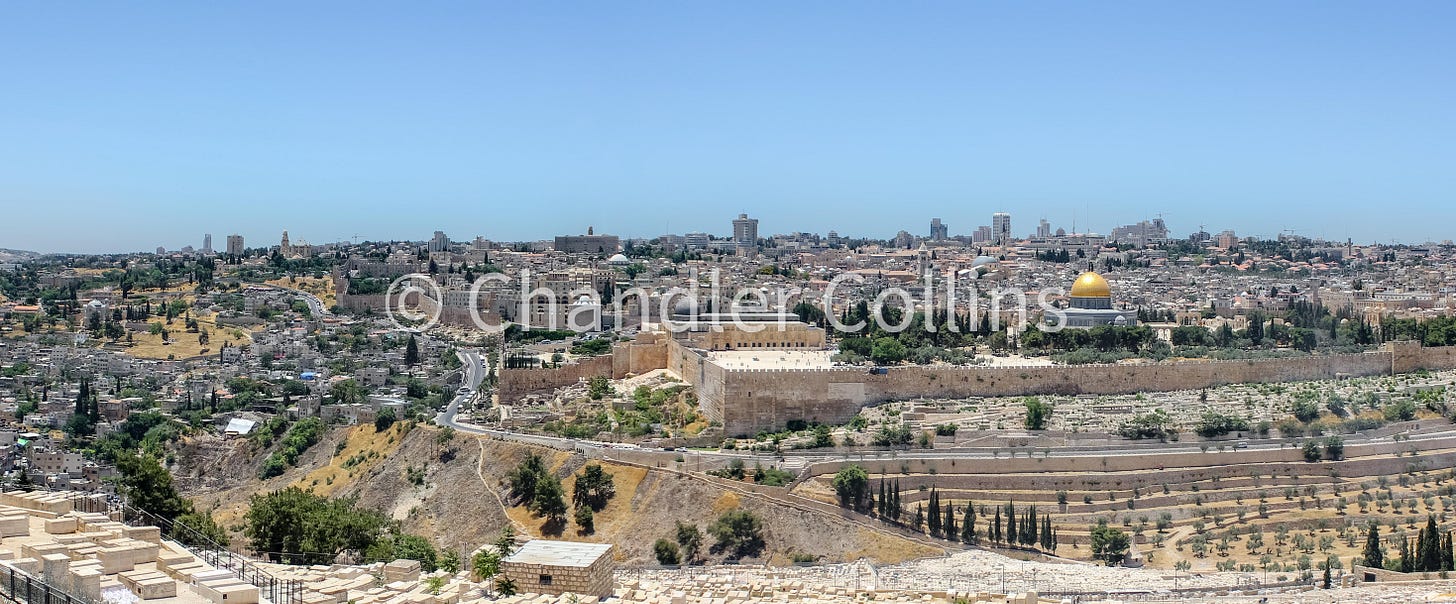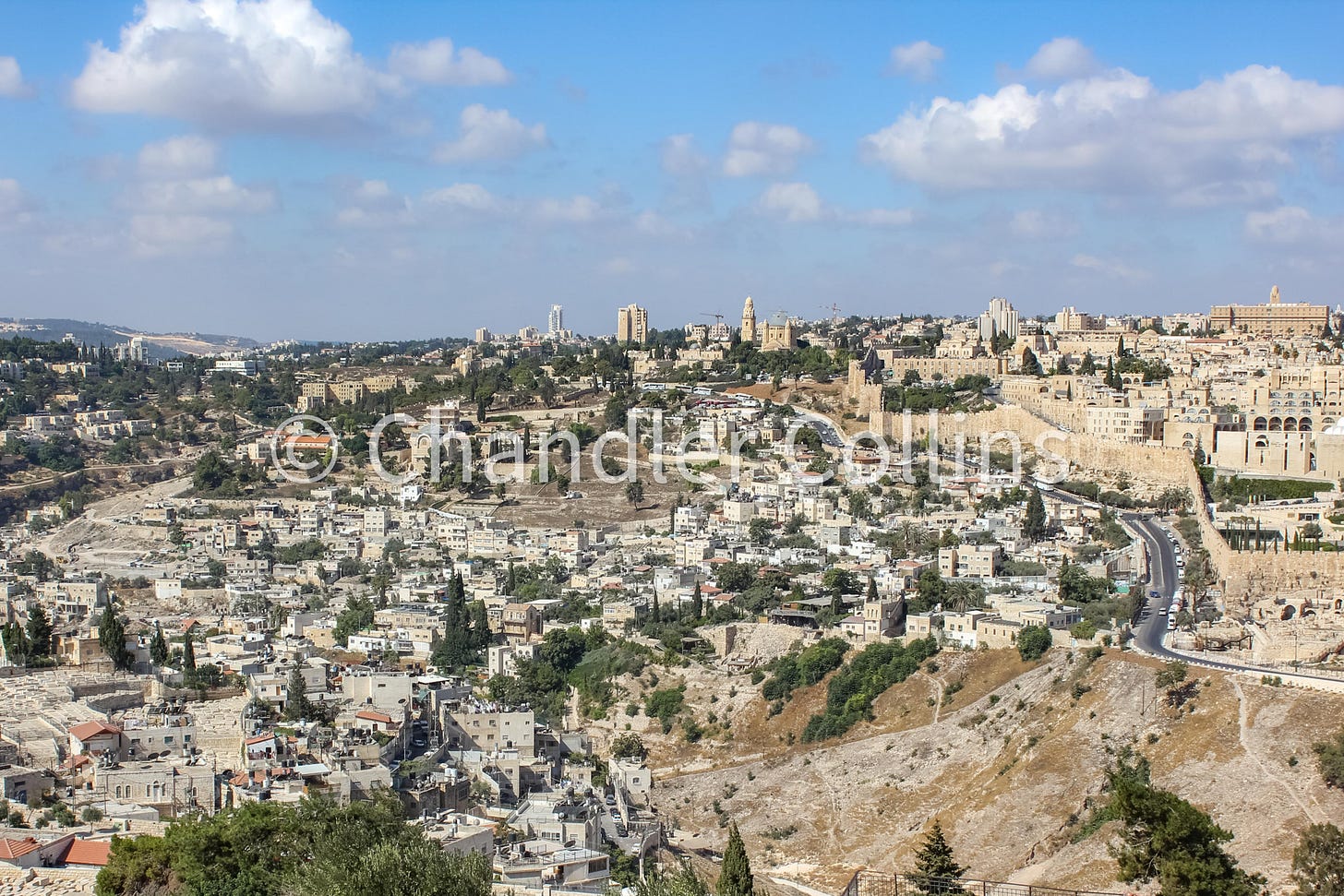Pinpointing the Ancient Core of Jerusalem
Today we reflect on a new article supporting a theory that attempts to relocate the hill where ancient Jerusalem was founded
If you find this newsletter valuable, consider upgrading to a paid subscription

A recently published article in the journal Tel Aviv has been highlighted in popular outlets and social media over the last week. Israeli scholar Nadav Na’aman presents new evidence in support of the idea that the ancient city of Jerusalem was founded not on the Southeastern Hill as has been agreed by archaeologists for some 100 years, but rather on the hill covered today by the Noble Sanctuary. This minority view which has been floating around scholarship for the last several decades finds renewed energy in Na’aman’s publication. Today’s newsletter looks at some of the issues surrounding what I will term the “Original Temple Mount Theory” (OTMT) that challenges traditional understandings of ancient Jerusalem.
What’s the theory?
For a century, the consensus among scholars has been that the ancient core of Jerusalem was located on the Southeastern Hill. The reason this idea came to be accepted was primarily archaeological. The majority of the oldest material remains in Jerusalem have been found on and around this hill, including pottery, fortifications, and other architecture. The Southeastern Hill also sits near the city’s perennial spring which scholars have understood as the reason settlement originally clustered in this area. This hill, then, would have been the location of the Canaanite city, the fortress of Zion, and the city conquered by King David.

One problem in the archaeology of Jerusalem is that we find meager material remains in some historical periods when written documents testify to activity in the city. A well-known example is the Late Bronze Age (ca. 1550-1200/1150 BCE), during which time the Amarna Letters inform us that Jerusalem had a local ruler, a palace, and presumably, some measure of control within in the Central Highlands. Another example is the Persian Period when the Bible describes the rebuilt walls and temple of Jerusalem, with other limited activity taking place in the city. But archaeology has provided very little evidence for life in Jerusalem during each of these periods. Scholars take different lines of reasoning to explain this, including various reinterpretations of the texts and/or archaeology. The OTMT raises the possibility that we’ve simply been looking for ancient Jerusalem in the wrong place.
In 2000 Ernst Axel Knauf authored an article in which he suggested that the original location of Jerusalem—the Canaanite city and city of David—should be sought on the ancient Temple Mount. Only in times of prosperity did the city extend down to and include the Southeastern Hill. Moreover, he argued that a Canaanite temple and royal palace had been built on the Temple Mount, and Solomon maintained continuity in this sacred space by later building the temple and palace here. Importantly, Knauf was aware that his theory could never be tested because when King Herod initiated the expansion of the historic Temple Mount platform and established new buildings there in the first century BCE, he boxed in and destroyed the earlier remains. Therefore, the OTMT can never be tested, even in the unlikely event that systematic excavations might ever take place within the Noble Sanctuary compound.

In 2011, an article appeared by Israel Finkelstein, Ido Koch, and Oded Lipschits which further developed Knauf’s idea and expanded it to include other periods of Jerusalem’s history. The article by Nadav Na’aman which was published last week presents previously undiscussed archaeological evidence that supports the OTMT. Na’aman points out that two fragments of cuneiform tablets were unearthed in the Ophel below the Noble Sanctuary. He understands these as the remains of letters that were sent to Jerusalem’s royal palace during the Late Bronze Age. The article also discusses some bullae and scarabs found in the same area from both the Middle and Late Bronze Ages. Na’aman believes this material was used in the royal palace that must have been located on top of the ancient Temple Mount above, and it later slid down into the Ophel area below. He suggests that in the second millennium BCE, Jerusalem had two walled areas that were disconnected from one another: one on top of the Temple Mount that included administrative buildings and the other on the Southeastern Hill near the spring. He concludes:
“…we may assume that the stronghold of Zion...conquered by David (2 Sam 5:7) was located at the site of the Late Bronze Age palace. Moreover, the building of the palace and temple on the Temple Mount, as related in the history of Solomon, was not a revolutionary step in the city’s history (as was postulated by generations of scholars), but rather, constituted a natural continuity in the history of the city, in which the palace, the seat of the ruling dynasty, and the temple were always located on the Temple Mount." (Na'aman 2023:122)

Responses
The OTMT has been widely criticized, and most scholars have not accepted it for a number of reasons:1
despite the strategic advantage of higher ground, it would create distance between the city of Jerusalem and the perennial spring on which the city depended
not many early artifacts are found on the west and east sides of the Noble Sanctuary where they presumably would have eroded over time or in the Temple Mount Sifting Project2
there are substantial early remains from a settlement on the Southeastern Hill, including fortifications, that suggest the city was located here
the supposed lack of archaeological remains in some periods on the Southeastern Hill may be overstated and depends on a number of presuppositions and interpretive issues
although impossible to disprove, we will never be able to test the OTMT archaeologically
Na’aman’s new article brings additional evidence to the table, but the argument rests on the assumption that the small artifacts he highlights did not originate in the Ophel where they were found and/or were not brought there from elsewhere in the city to be used as fill material in later construction. Even if the OTMT has not attracted the support of many scholars, Na’aman’s recent article suggests it is not going away any time soon and will need to be readdressed.
Shifts and reminders
The scholars advocating for a major shift in our understanding of ancient Jerusalem provide a helpful reminder that topographical dogmas in Jerusalem are few and far between. Our understanding of the ancient city is not authoritative but must be constructed on the basis of available evidence. Although it may sound surprising today, nearly all scholars once thought that the original city of Jerusalem and fortress of Zion sat on the high and defensible Western Hill (Mount Zion). By the very end of the 19th century, archaeologists were able to challenge this prevailing view with strong material evidence from the Southeastern Hill. At the time, the idea ruffled more than a few feathers, as objections to a popular consensus usually do. Over 100 years later, the same kind of energy radiates in the challenge posed by the OTMT.

Personally, for the reasons listed above and others, I think the OTMT creates more problems than it solves, but considering it provides a helpful exercise in which we can turn our assumptions about ancient Jerusalem upside down and see if the data looks the same from the other side. The fresh angle has the potential to bring understandings that would not have otherwise been possible. It may be that Na’aman’s new article serves as the catalyst to consider evidence that has been overlooked. Even if the majority of scholars retain the traditional view, in considering issues highlighted by the OTMT, we may learn to nuance and develop our understanding of ancient Jerusalem in helpful ways. The scholarly conversation is always worth having.
Looking at the big picture, it is good to remember where scholars who study ancient Jerusalem agree: the royal, administrative, and cultic core of the early city is to be found on the eastern ridgeline. Evidence from a host of sources, including: inscriptions, bullae, luxury imports, urban planning, nuanced readings of the biblical text, and others suggest that the main institutions of the ancient city sat along this ridge and not elsewhere. Scholars also agree that these institutions included the Judahite temple and royal palace (perhaps with precursors of some form omitted in the Bible) which was located on the ancient Temple Mount. Time will tell how scholarship responds and adapts to the newest iteration of the OTMT in this future.
See especially Ussishkin 2015:139-141; Pioske 2015:190-193; Geva and De Groot 2017; Locatell et al 2022:104.
This dirt was removed from the southeastern area of the Noble Sanctuary by the Waqf during the construction on the Marwani Mosque (for details, see Lawler 2022). Scholars disagree whether the debris originated on the Temple Mount or was brought there later as fill material. We may be in a better position to evaluate the issue with data provided in the forthcoming book Capitalizing Jerusalem: Mu'awiya's Urban Vision 638-680 by Beatrice St. Laurent and Isam Awwad.
Enjoy this post?
Show your appreciation by leaving a tip as low as the price of a cup of coffee.
Follow Approaching Jerusalem
View previous editions of this newsletter or follow us on social media for archaeological stories, upcoming lectures, and other Jerusalem-related news, resources, and analysis.

